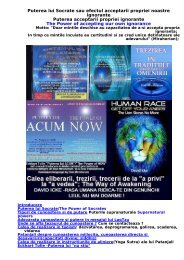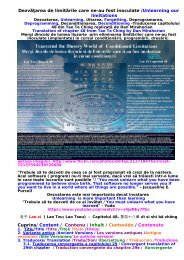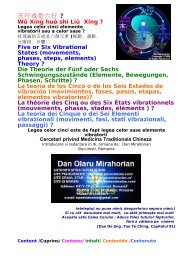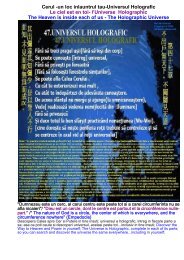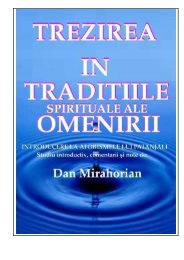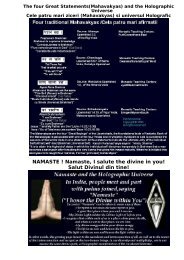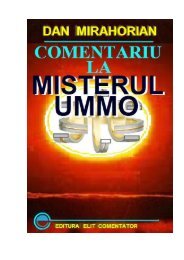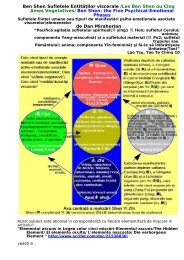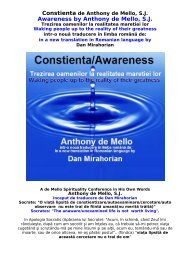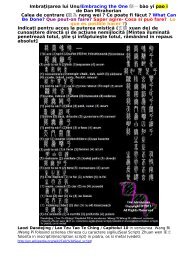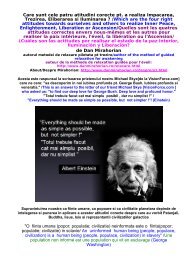Centre energetice subtile in diferite traditii spirituale de ... - Mirahorian
Centre energetice subtile in diferite traditii spirituale de ... - Mirahorian
Centre energetice subtile in diferite traditii spirituale de ... - Mirahorian
You also want an ePaper? Increase the reach of your titles
YUMPU automatically turns print PDFs into web optimized ePapers that Google loves.
Vajrayana, or Tantric Buddhism, has been <strong>de</strong>scribed as the latest phase <strong>in</strong> the<br />
<strong>de</strong>velopment and evolution of Buddhist thought. For a long time, Western scholars<br />
dismissed Vajrayana as the f<strong>in</strong>al "<strong>de</strong>generate phase" of Buddhist thought. This<br />
attitu<strong>de</strong> was due to the fact that these materialistic scholars had only a Christian or a<br />
secular way of see<strong>in</strong>g the world. They could appreciate ord<strong>in</strong>ary Buddhism<br />
(Theravada, etc), see<strong>in</strong>g the Buddha as the Christ of the East teach<strong>in</strong>g an essentially<br />
moral message, or as a sort of spiritual humanist; but when faced with a system of<br />
knowledge and practice that embraced all the magical and occult elements that<br />
Western rationalism had rejected centuries ago, could only expla<strong>in</strong> it as some sort of<br />
<strong>de</strong>generate end phase.<br />
Fortunately, <strong>in</strong> more recent times other Westerners have studied Tantric Buddhism<br />
first hand, at the feet of actual Tibetan Masters, and so have a more mature<br />
appreciation and respect for that noble tradition. In<strong>de</strong>ed, if anyth<strong>in</strong>g good has come<br />
out of the terrible Ch<strong>in</strong>ese <strong>in</strong>vasion and oppression of the Tibetan homeland <strong>in</strong> the 2nd<br />
half of the 20th century, it has been that this has driven Tibetan lamas and teachers to<br />
the West, and encouraged them to spread their tradition among sympathetic<br />
Westerners.<br />
Vajrayana metaphysics is, like Indian Tantra, a hybrid affair: a com<strong>in</strong>g together of<br />
Indian Tantrism, Mahayana Buddhism, and the orig<strong>in</strong>al aborig<strong>in</strong>al shamanism - the Bon<br />
tradition - of Tibet itself. Like the Nathas, Shaktas, and Shaivites, the Vajrayanists<br />
postulated a subtle or iconographic body, ma<strong>de</strong> up of chakras, nadis, and subtle w<strong>in</strong>ds<br />
(vayu). And like their Indian counterparts they worked on manipulat<strong>in</strong>g the forces of<br />
this subtle body through yoga <strong>in</strong> or<strong>de</strong>r to atta<strong>in</strong> spiritual enlightenment. But Vajrayana<br />
tantra diverged very early from Indian tantra. Instead of the later seven-chakra<br />
mo<strong>de</strong>l, they reta<strong>in</strong> an earlier four chak-ra schema of navel, heart, throat, and head<br />
centres. Start<strong>in</strong>g from this four-chakra foundation, the Vajrayanists - like the Indian<br />
tantics - built up a very elaborate system of correspon<strong>de</strong>nces.<br />
There are a number of other important differences to Indian (Shakta) Tantra as well.<br />
In Indian tantra one starts form the base chakra and progresses up. In Tibetan tantra<br />
one starts from the head, which is the "lowest" level of consciousness (body, wak<strong>in</strong>g<br />
consciousness, wrathful <strong>de</strong>ities), and progresses down to the heart, which is the<br />
highest level of consciousness.<br />
With Indian Tantra the kundal<strong>in</strong>i is awakened through specific breath<strong>in</strong>g practices and<br />
yoga-postures. The prana or vital-force of the subtle body is thus manipulated through<br />
the breath and the physical body; through an extension of Hatha yoga which, the<br />
rea<strong>de</strong>r will recall, was associated from the beg<strong>in</strong>n<strong>in</strong>g with Indian Tantra. In contrast,<br />
Vajrayana practice <strong>in</strong>volves manipulat<strong>in</strong>g the vital force through the m<strong>in</strong>d and<br />
concentration. Through <strong>in</strong>tense visualisation of <strong>de</strong>ities and so on, one activates the<br />
<strong>in</strong>ner "w<strong>in</strong>ds" (= prana = ch'i) and "drops".<br />
The Instead of the Kundal<strong>in</strong>i-Shakti or "Serpent Fire" of Shakta Tantrism, Vajrayana has<br />
the Tumo (literally "fierce woman"). Through <strong>in</strong>tense visualisation of <strong>de</strong>ities and<br />
concentration upon the "lower tip" (the m<strong>in</strong>or chakra at the tip of the sex-organ), the<br />
w<strong>in</strong>ds (prana) are drawn <strong>in</strong>to the lower open<strong>in</strong>g of the central channel (sushumna),<br />
produc<strong>in</strong>g an <strong>in</strong>tense heat, called tumo [Daniel Cozort, Highest Yoga Tantra, p.71]. In<br />
her fasc<strong>in</strong>at<strong>in</strong>g book, Magic and Mystery <strong>in</strong> Tibet Alexandra David-Neel popularised<br />
stories of Tibetan yogis dry<strong>in</strong>g icy sheets with their naked bodies outsi<strong>de</strong> <strong>in</strong> the middle<br />
of w<strong>in</strong>ter. That is a showy exhibition of tumo. Real tumo of course is the tantric<br />
meditation itself.<br />
As a result of the tumo-heat, the drops melt and enter the central channel. The red<br />
"female" drops <strong>in</strong> the navel chakra ascends to the heart chakra, while the white drops<br />
<strong>in</strong> the crown chakra <strong>de</strong>scend to the same chakra. The bliss of the drops flow<strong>in</strong>g <strong>in</strong> the<br />
central channel is said to be a hundred times greater than that of orgasm [p.71]. The<br />
drops, mov<strong>in</strong>g up or down the central channel, f<strong>in</strong>ally enter the "<strong>in</strong><strong>de</strong>structable drop"<br />
<strong>in</strong> the heart chakra, so called because it is said to be drop that passes from life-time to<br />
life-time, tak<strong>in</strong>g with it the "very subtle m<strong>in</strong>d" and "very subtle w<strong>in</strong>d" [p.72].<br />
The entire visualisation or meditation stage itself is called the stage of Generation, as<br />
its purpose of is to construct or generate an actual enlightenment or buddha-body, the<br />
stage of Completion. The result of all this is that one rises <strong>in</strong> an "illusory body", so



